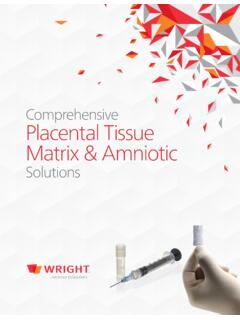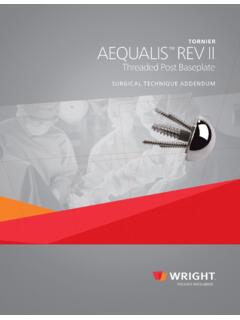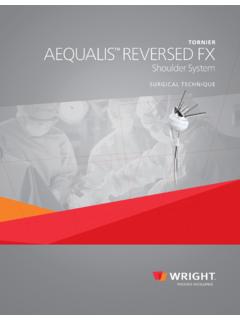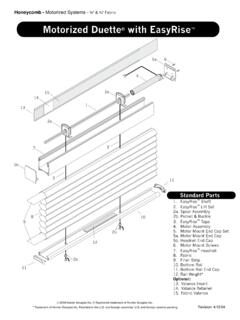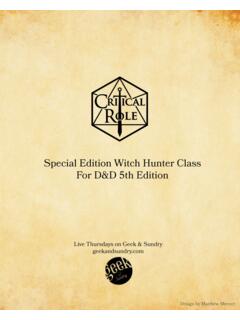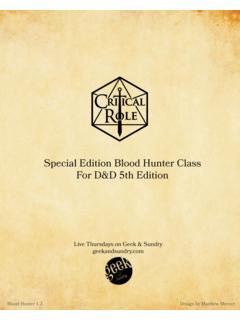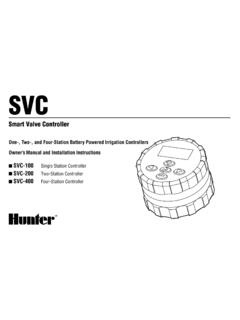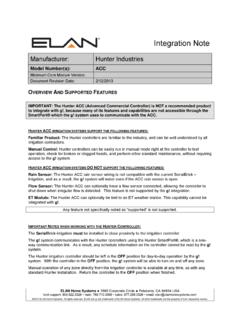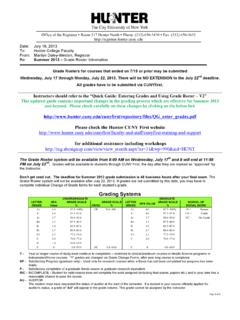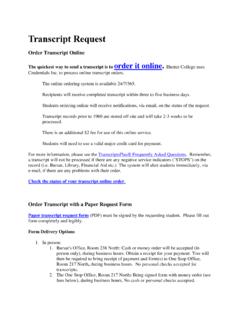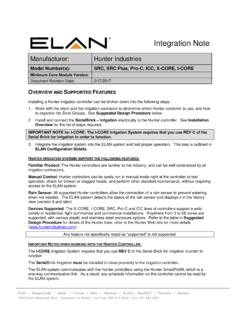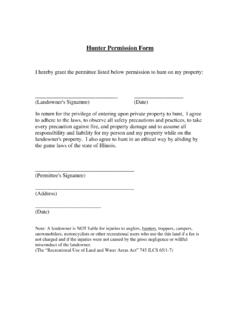Transcription of HUNTER - eMedia
1 HUNTER Tendon ImplantsSURGICAL TECHNIQUE HUNTER active TENDON IMPLANT surgical technique 1 5 HUNTER passive TENDON IMPLANT surgical technique 6 10 The HUNTER Active Tendon Implants consist primarily of an implant comprised of a polyester core covered with silicone elastomer (barium-impregnated for radiopacity). The HUNTER Active Tendon Implant is double-pouched, and is STERILE unless the inner pouch is opened or HUNTER Active Tendon Implants are indicated for use in stage one of the two-stage procedure developed by Dr. James M. HUNTER for the recon-struction of flexor and extensor tendons in individuals having significant hand tendon injury. The device is intended to be implanted temporarily in order to encourage the formation of a pseudosynovial sheath which will later nourish and lubricate an autogenous tendon interval between Stage One (implantation of the device and formation of the pseudosynovial sheath) and Stage Two (removal of the device and autogenous tendon grafting) should be two to six months to permit maturation of the tendon bed to the point where it can nourish and lubricate a tendon graft.
2 The surgeon must determine, on the basis of the findings in the hand, the appropriate time within that period at which to commence Stage Two of the procedure. The HUNTER Active Tendon Implants are specifically indicated in cases in which proximal anastomosis must be executed deep in the proximal forearm. They may also be used, at the surgeon s discretion, in patients having small pulleys which, unless opened surgically, will not permit insertion of a HUNTER Active Tendon Implant with a proximal device is not intended for any use other than that indicated. Residual antecedent infection is a contraindication for the use of this device. Appropriate surgical and antimicrobial treatment and subsequent wound healing will allow the procedure to be carried out at a later date. A digit that has a scarred tendon bed, borderline nutrition, nerve deficit and severe joint stiffness could possibly be salvaged; however, this should probably be undertaken only in the patient with very special requirements.
3 Subsequent functional expectations are TENDON IMPLANT device DESCRIPTIONS indicationscontraindications FOR TENDON RECONSTRUCTIONoneHUNTER ACTIVE TENDON IMPLANTAT |ATDC |ATBC |ATPC |Complete indications, contraindications, warnings, and precautions are listed in the implant package insert and should be viewed by the physician and operating room The following procedure is offered as an aid to the surgeon and is not intended to replace individual clinical judgment. The following instructions for use of the HUNTER Active Tendon Implants are based on the surgical procedures employed by Dr. James M. HUNTER , who participated in the development of the device. Note that only the methods for implantation and removal of the device are presented ONE PREPARATION1. The damaged flexor tendons and their scarred sheaths are exposed by means of the Brunner zigzag incision in the finger and palm.
4 The proximal portions of the flexor tendons and their musculotendinous junctions in the forearm are exposed by means of a curvilinear incision on the volar ulnar aspect of the The retinacular pulley system should be preserved or reconstructed. An adequate, intact pulley system is essential for good function. When the retinacular pulley system is inadequate and bowstringing is noted, reconstruction of the system is indicated. Four pulleys are preferable (A1, A2a, b, A3, A4).3. All scar tissue should be meticulously excised. The entire system from the proximal edge of A1 pulley to the distal phalanx should be exposed and explored. All remnants of the flexor tendons should be excised through multiple transverse incisions in the retinacular pulley systems. Contracted or scarred lumbrical muscle should also be excised in order to prevent paradoxical motion of the lumbricals after tendon Undamaged portions of the flexor fibro-osseous retinacula which are not contracted are OF THE ACTIVE IMPLANT5.
5 Pass the device in a distal-to-proximal direction. Moistening the device with sterile Ringer s solution will facilitate this process. Advance the proximal cords through the pulleys and use the cords to gently pull the implant portion Pass the device from palm to forearm through the carpal canal in a similar manner. Prepare the canal by passing a blunt metal obturator instrument (such as the Ober tendon passer) superficial to the profun-dus tendon and pull the polyester cords into the forearm. Use the cords to gently pull the implant portion through. Observe the distal fixation component and guide it to a position slightly proximal to its anticipated location over the FOR USEtwoHUNTER ACTIVE TENDON IMPLANTP roper surgical techniques are nessarily the responsibility of the medical professional.
6 The following guidelines are furnished only as recommended techniques. Each surgeon must evaluate the appropriateness of the techniques based on his or her own medical training and ATTACHMENTS FOR TYPES AT, ATPCNOTE | To secure the distal component to bone in a way which will achieve a strong, durable juncture, the following technique devel-oped by Dr. HUNTER should be recommended bone screw is a stainless steel mm bi-cortical screw (with cruciform recess).NOTE | ALTERNATE DISTAL ATTACHMENTS. The distal component is designed to permit fixation with twisted wire through bone, as well as with screw. If, during preparation for screw insertion, the screw fixation is inadequate, fixation with twisted wire can be utilized. | FIGURES 2A, 2B, 2C If the bone has been fractured or shows osteopo-rosis, fixation with twisted wire through a single lateral drill hole is preferred | FIGURES 3A, 3B, 3C.
7 In either case, the distal fixation com-ponent must be attached tightly and securely to the bone to prevent slippage during cyclic motion. When completing fixation, always base the twist on the edge of the fixation component and tuck excess bulk into the countersink of the A strip of profundus should be retained, drawn over the distal compo-nent and sutured laterally to act as a soft tissue Remove the tourniquet, review all wounds, wash out and close the distal ATTACHMENTS FOR TYPES ATDC, ATBC1. The ideal position of the implant is with the distal end of the rod por-tion 2 to 3 mm distal to the joint. With this in mind, a transverse drill hole approximately 2 mm in diameter is placed through the phalanx in an area of good bone stock, preferably cortical With the implant in position, insert each polyester cord into the drill hole from each cord s respective side.
8 Thread each cord out through its opposing side, drawing it up tightly so that no slippage of the implant can occur during cyclic active Tie the cords in a surgeon s knot on the volar aspect of the phalanx. Check tightness of knot and stability of implant. Cut excess cord with electric Remove the tourniquet, review all wounds, wash out and close the distal ACTIVE TENDON IMPLANT| FIGURE 1A | FIGURE 1B| FIGURE 2A | FIGURE 2B | FIGURE 2C| FIGURE 3A | FIGURE 3B | FIGURE 3C| FIGURE 4A | FIGURE 4B | FIGURE 4C| FIGURE 5A | FIGURE 5B | FIGURE 5 CPass the selected tendon through the implant loop (A), then through a small longitudinal split in the tendon (B). Place one suture through the tendon (C) and test the tension. Test tension by moistening the implant surface, followed by flexion and extension of the wrist.
9 The finger should lay in extension during wrist flexion and show a position of balance with the adjacent fingers on wrist extension. If balance is acceptable, place a second suture and turn the tendon 90-degrees through one or two additional longitudinal splits in the tendon (D). Re-test tendon balance and be sure there has been no loss of tendon ATTACHMENTS FOR TYPES ATPC, ATBC1. Select motor tendon: The profundus motor is of first preference, the superficials, second. Desired excursion of the motor tendon is 4 cm for the FDP and 3 cm for the FDS. 2. The rod portion of the tendon can be shortened if necessary. With care, the silicone rubber can be peeled away from the polyester cord at the proximal end and trimmed with a scalpel. Care must be taken not to damage the polyester weave during this step.
10 The two cords are attached by sewing crossing stitches of dacron from side to side. These stitches must be carefully cut to free the two dacron cords for the attachment to bone or tendon during the reconstructive The proximal cords are woven into the lateral borders of the motor tendon and fixed with Mersilene sutures at points of exit. Approxi-mately 10 mm from the end of the motor tendon, make a small (2 to 3 mm) longitudinal slit in the lateral aspect of the motor tendon to al-low passage of a fine line curved hemostat. Insert the hemostat, with its tip moving distally, into the slit such that the tip exits from the end of the motor tendon | FIGURE 7A. Grasp the corresponding tendon cord with the hemostat and draw it back through | FIGURE 7B. Repeat the procedure on the opposite side. After each cord has been passed through the tendon one time, draw the tendon up so the proximal fourPROXIMAL ATTACHMENTS FOR TYPES AT, ATDC1.
